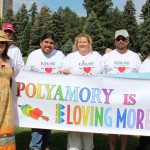Polyamory Research Survey Background
From February 10th to April 2nd 2012, Loving More, with the endorsement of the National Coalition for Sexual Freedom (NCSF) conducted an internet-based survey of over 4000 participants who self-identify as polyamorous. This is the largest survey of self-identified polyamorous individuals to date. Individuals were recruited through local and regional listserves, Loving More email list, the PolyResearchers list, the Institute for Advanced Study of Human Sexuality’s (IASHS) student and alumni lists, and the American Association of Sexuality Educators, Counselors and Therapists’ (AASECT) AltSex list. With the exception of five questions, all the questions were drawn from among those asked in the NORC’s[1] biennial General Social Survey (GSS) in order to compare a sample of the polyamory community with the general US adult population.
Investigators:
Jim Fleckenstein
 Owner, The Earth Moved, LLC
Owner, The Earth Moved, LLC- Co-Editor, What Psychology Professionals Should Know About Polyamory (2009, 2012)
- Presenter at six AASECT/SSSS conferences
Curtis R. Bergstrand, Ph.D.
 Associate Professor and Director of the Sociology/Criminal Justice Studies Dept., Bellarmine University (KY)
Associate Professor and Director of the Sociology/Criminal Justice Studies Dept., Bellarmine University (KY)- Author, Swinging in America: Love, Sex, and Marriage in the 21st Century (2010)
Derrell W. Cox II, MA*
 Doctoral Candidate, Department of Anthropology, University of Oklahoma
Doctoral Candidate, Department of Anthropology, University of Oklahoma- Presenter at several international scientific conferences in sexuality and in childhood development
Demographics
Sample Size
The Loving More survey (hereafter, LM) had a total of 4,062 participants ranging in age from 16 to 92. The GSS surveys conducted from 1972 to 2012 have a total of 57,061 participants ranging in age from 18 to 99. The average age of the LM participant was significantly[2] younger at just over 40, compared with the GSS participant who was nearly 48 years old on average.
Gender
Respondents in the LM Survey were asked to identify as either male or female, based upon the need to match the GSS, but were given space to comment. This was a limitation of the LM survey and the one question with which participants were most dissatisfied. Almost half of the LM respondents identified as female (n=2011, 49.5%), 35.4% identified as male (n=1439), and 15.1% (n=612) of the LM respondents did not respond to the question. Of these, 172 (4.2% of the total LM population) identified as gender queer, gender fluid, transsexual, Two-spirit, questioning, or other. In the GSS, 55.9% (31,915) of the respondents identified as female and 44.1% (25,146) identified as male. There were no other gender options for GSS respondents.
FIGURE 1: Respondents' Gender
Gender of Partners
The LM respondents were not asked to identify their sexual orientation as lesbian, gay, bisexual, straight, or other. Rather, consistent with the GSS, they were asked to describe the gender of their sexual partners over the previous year. Likewise, no effort was made to force respondents to define “sex” or “sexual”, again consistent with the GSS. Consequently, when respondents are characterized as lesbian, gay, bisexual, or heterosexual/straight in this article, it refers to their indicated recent behavioral practices rather than their subjective sexual orientation. Thus, it is possible that a female may identify as bisexual, but if her partners in the previous year as reported on the survey were only males, then she will be considered behaviorally heterosexual for statistical analysis purposes. Table 1 and Figure 2 describe the behavioral identification of the LM and GSS survey participants. Sex of partner was not asked in all years of the GSS surveys.
TABLE 1 & FIGURE 2: Sex of Survey Respondents’ Partner(s) in the Last 12 months
| Respondents | n (%) | Same | Both | Opposite |
| LM FEMALE | 1970 | 111 (5.6) | 912 (46.3) | 947 (48.1) |
| GSS FEMALE | 11014 | 225 (2.0) | 78 (0.7) | 10711 (97.2) |
| LM MALE | 1397 | 53 (3.8) | 262 (18.8) | 1082 (77.5) |
| GSS MALE | 9752 | 288 (3.0) | 61 (0.6) | 9403 (96.4) |
Educational Attainment
Based upon these survey results, the LM population[3] is significantly more educated, with a Bachelor’s degree being the most commonly-held degree, while a high school diploma is the most commonly-held degree among the general US population. Table 2 provides details of educational attainment from both the LM 2012 survey (compared to the GSS 2012) and the LM 2000 survey[4] (compared with the GSS 2000). Differences between the LM and GSS respondents were significant across all educational levels.
FIGURE 3: Educational Attainment
TABLE 2: Educational Attainment
| Highest Degree Completed | LM 2012 n=3575 (%) |
GSS 2012 n=2044 |
LM 2000 n=1010 |
GSS 2000 n=2799 |
| Less than High School | 29 (0.8) | 288 (14.6) | 8 (0.8) | 439 (15.6) |
| High School Diploma | 619 (17.3) | 976 (49.4) | 36 (3.6) | 1501 (53.3) |
| Junior College | 693 (19.4) | 151 (7.6) | 257 (25.4) | 206 (7.3) |
| Bachelor’s | 1253 (35.0) | 354 (17.9) | 306 (30.3) | 435 (15.4) |
| Graduate | 981 (27.4) | 205 (10.4) | 399 (39.4) | 218 (7.7) |
As may be seen in the table and graphic above, the level of educational attainment of LM 2012 survey respondents appears to be less than that of the LM 2000 respondents. However, when looking at middle-aged respondents from 2000 (40-50 age group) with their cohort in 2012 (52-62 age group), the average (mean) educational attainment was significantly less for the aged population. This, and other analyses, suggests that the respondents in 2012 were from a broader spectrum of society than the 2000 respondents. In the words of Robyn Trask, Executive Director of Loving More:
My educated guess is the discrepancy in education levels between the 2000 Loving More Survey and 2012 Survey is due to growth of interest in polyamory. In 2000, the polyamory movement was tiny, but in the past five years we have seen an influx of people from a much broader spectrum of backgrounds. In 2000 for example, the internet was growing but still most who used it were better educated. The internet has been instrumental in polyamory awareness and interest. Today, most people have regular access to the internet and thus access to information about polyamory and connection with groups. Growing awareness has grown the ranks of people identifying as polyamorous and as it opens up to more awareness, it is more likely to peak interest of people in mainstream society.
Household Composition
LM 2012 respondents indicated that they have more adults but fewer children, preteens, and teenagers, on average, living in the household than GSS respondents. The household composition significantly differed between the two populations across all of these age categories.
Results
Marriage Policy and Polyamory
The first three questions on the LM 2012 survey were not asked in the GSS, but examined policy-related issues for polyamorous individuals. These policy-related questions asked about: openness to legal marriage for polyamorous families; whether multi-party marriages ought to have the same legal equity as monogamous marriages; and whether any relationships ought to enjoy special privileges over other forms of relationships because of their value to society.
Openness to Legal Concurrent Multiparty Marriage
LM 2012 respondents were asked, “If it were legal, would you be open to being married to more than one person concurrently?” Nearly two-thirds (65.9%) of respondents answered “yes,” 19.7% answered “not sure,” and 14.4% answered “no.” In the LM 2000 survey, respondents were asked the same question, but were only given yes or no options with additional space for comments. This dichotomous option makes comparison with the LM 2012 survey challenging (and statistically reliable results impossible) in that it is unknown how many in 2000 might have responded “not sure” instead of “yes” or “no” if given the option. In the LM 2000 survey, 76.7% answered “yes,” 19.6% answered “no,” and 3.7% either gave no answer, left comments only, or stated “don’t know.”
FIGURE 4: Openness to Multiparty Marriage
Legal Recognition and Equity before the Law
LM 2012 survey respondents were given the statement, “Smith believes that consensual, multi-party marriages among adults should enjoy the same legal recognition, privileges and obligations as two-party marriages. Jones believes that only two-party marriages deserve legal recognition,” and were then asked to indicate their opinion on a 5 point Likert scale, from strongly disagree to strongly agree. A large majority (91.9%) of all respondents supported multi-party marriage (i.e. agreed or strongly agreed with Smith), 91.5% of currently married respondents agreed with Smith, and 93.1% of currently unmarried respondents supported multi-party marriage.
FIGURE 5: Equity among Marriage Types
Social Utility and Monogamous Privilege
Another statement on the LM 2012 survey, “Jones believes that any form of intimate relationship between consenting adults is fine, but that none deserve special recognition or privileges. Smith believes that certain types of relationships are more socially valuable than others and deserve official recognition and privileges in order to encourage their formation,” addresses opinions about the oft-heard assertion that monogamous (and presumably heterosexual) marriages ought to be privileged due to their social value. 66.9% of all respondents believe no relationship configuration deserves special recognition (i.e., agree with Jones); 62.0% of currently married respondents agreed with Jones; and 70.6% of unmarried respondents believe no relationship configuration deserves special recognition.
FIGURE 6: Social Utility and Privileged Monogamy
Comparison between LM Polyamorous Individuals and the General Population
Marriage
 The next questions compare the perspectives of the LM respondents with those from the GSS concerning bad marriages, the value of individual autonomy versus companionship in marriage, and the seriousness of marriage in a climate of easy divorce. For the following three statements, respondents were asked to indicate their opinion on a 5-point Likert scale, ranging from strongly agree (1) to strongly disagree (5).[5] The results from the LM 2012 and GSS survey were averaged and their means were compared.
The next questions compare the perspectives of the LM respondents with those from the GSS concerning bad marriages, the value of individual autonomy versus companionship in marriage, and the seriousness of marriage in a climate of easy divorce. For the following three statements, respondents were asked to indicate their opinion on a 5-point Likert scale, ranging from strongly agree (1) to strongly disagree (5).[5] The results from the LM 2012 and GSS survey were averaged and their means were compared.
Better to Have a Bad Marriage?
Both the GSS and LM respondents disagreed on average with the statement, “it is better to have a bad marriage than no marriage at all.” However, the LM respondents were significantly stronger in their disagreement with this statement than the GSS respondents.
Personal Freedom vs Companionship in Marriage
The opinions of the LM respondents were significantly different from those of the GSS in response to the statement, “personal freedom is more important than the companionship of marriage.” LM respondents were more likely to agree with this statement, while GSS respondents were more likely to disagree.
Seriousness of Marriage
The opinions of the LM respondents also significantly diverged from the general population in response to the statement, “couples don’t take marriage seriously enough when divorce is easily available.” GSS respondents, on average, agreed with this statement, while LM participants disagreed.
Happiness in Marriage
GSS and LM married survey respondents were asked, “Taking all things together, how would you describe your marriage—very happy, pretty happy, or not too happy?” On average, both the LM and the GSS respondents indicated they were just beyond the halfway point between the pretty happy and very happy range (closer to very happy), but LM respondents were slightly (though statistically significantly) less inclined to describe their marriage as “very happy.”
Personal Well-being
Happiness in General
Survey respondents were asked to respond to the following question, “Taken all together, how would you say things are these days—would you say that you are very happy, pretty happy, or not too happy?” On average, both LM and GSS respondents were between “pretty happy” and “very happy,” but the LM population was slightly, but significantly, happier than the general population.
FIGURE 7: Happiness
Health
In response to the question, “Would you say your own health, in general, is excellent, good, fair, or poor?” both LM and GSS respondents indicated on average being in good health. Similar to the results from the question on general happiness, LM respondents reported being in better health than adults in the general population. The differences in mean score were small, but significantly different.
FIGURE 8: Health
Equality in Relationships
There exists a substantial body of research that examines the perceived equity in relationships and its consequences for relationship satisfaction. One of the more significant measures of perceived equity in relationships is the sharing of household duties. While admittedly not as applicable to those who don’t routinely cohabit, we chose a single question from the GSS as an initial measurement for the perceived equity in the relationships of polyamorous respondents. Future research will pursue this question in greater depth. In contrast to popular opinion regarding polyamorous relationships, especially as they have been conflated with polygyny[6] or polygamy among historical Mormons (or present fundamentalist Mormon sects) in the US or polygamy as practiced in the non-western world, the LM sample felt that there was a more equitable distribution of domestic labor in their relationships than did the GSS sample. This was especially true for LM women as compared to GSS women. There were no statistically significant differences between men in the LM sample versus the GSS sample, though the trend was towards reporting a more equitable distribution of housework and domestic duties among LM men as well.
Safer Sex
Not surprisingly, and in keeping with general polyamorous ideologies of rigorous honesty in sexual relationships, the LM population was much more likely to have had an HIV test in the previous year as compared with the general population. Recently published research by Conley et al. (2012) found that consensually non-monogamous individuals were significantly more likely to have practiced safer sex with all partners, to have undergone STI testing, and to have had conversations about safer sex practices than were sexually unfaithful individuals in ostensibly monogamous relationships.
FIGURE 9: Ever Had an HIV Test?
Number of Partners and Frequency of Sexual Activity
Again to no one’s surprise, LM respondents reported more frequent sexual activity and with more partners than the general population. This was true across genders, lifespan, and behavioral sexual orientations between the LM population and the general population. In the charts below, the average (μ=mean) number of partners and frequency of sex during the past year of LM 2012 and GSS 2012 respondents are indicated by gender.
FIGURE 10: Number of Sexual Partners in the Past Year
FIGURE 11: Frequency of Sex over the Past Year
Discrimination
LM respondents were significantly more likely (28.5%) to report having experienced some form of discrimination in the past 10 years compared to the general US population (5.5%) and more than twice as likely than African Americans within the US population (12.8%). These results were similarly significant when analyzed by gender and sexual behavioral orientation. Ambiguity about having experienced discrimination is far more common among the LM population (18.4%) as compared to the general US population (0.13%) and among African Americans surveyed in the GSS (0.0%).
FIGURE 12: Experienced General Discrimination
When the LM respondents were asked specifically about discrimination in the past 10 years for being polyamorous, 25.8% answered “yes,” 53.4% answered “no,” and 20.8% answered “not sure.” Polyamorous women (28.9%) were significantly more likely to state that they had experienced discrimination for being polyamorous than were men (20.6%).
FIGURE 13: Experienced Discrimination for Being Polyamorous
In the LM 2000 survey, 42.8% of respondents indicated that they had experienced some form of discrimination for being polyamorous. However, unlike the LM 2012 survey, respondents in the LM 2000 survey did not have the option of answering “not sure,” forcing a dichotomous response. If it could be safely assumed that the large majority of uncertain responses from the LM 2012 survey would shift towards a “yes” answer if not given the option of “not sure”, then the percent of respondents indicating that they had experienced discrimination would be similar.
Summary
Compared with the general adult population represented by the GSS, the LM sample is younger, more educated, happier, healthier, and more sexually active with more people. The findings from comparison between the GSS and the LM responses are a little curious. A number of the questions asked indicated significant differences between LM and GSS respondents, but other, similar questions resulted in very different trends, especially when asked about happiness versus satisfaction with health, friendships, romance, marriage, etc. We suspect that a couple of important factors relevant to the LM sample may be driving these curious results. One may be that the LM population is less influenced by social desirability bias than the GSS respondents. That is, while the general population may be inclined to answer “Great” or “Fine” to the question, “How are you?”, LM respondents may just as well give a thoughtful and truthful answer in line with a widely-held value of rigorous honesty within the polyamorous community. Another, but related, factor may be related to the significantly higher educational status of LM respondents and their highly rational assessment of all questions posed to them. In the words of one long-term polyamory activist and advocate, Jim Fleckenstein, poly folk have a life- and relationship-orientation that is “deliberative, ruminative, and picky.” They have deep friendships and connections, but they also have high expectations for these interpersonal relationships.
Limitations and Caveats
It is important to acknowledge and understand some of the limitations of the analyses reported here.
The GSS surveys are large, national, randomized samples of the general population, which suggests they are a fair representation of the general population in the US. The LM survey population is comprised of individuals who self-selected and chose to participate on their own volition having been recruited through the Loving More website, and other listserves or contact lists that would be more likely to have significant number so of self-identified polyamorous people.
Inherent limitations that must be accepted include:
- Self-selected respondents may have various motivations to respond to a survey, which may skew the results and result in a biased sample.
- Some people who are polyamorous, but who are apathetic about research on polyamory, may have chosen to ignore the opportunity to participate.
- Because the LM survey was conducted via an online survey website, the respondents are more likely to be better educated, affluent, and more likely to be web literate.[7]
- People who practice some form of consensual, non-monogamy that would be included under the general term polyamory, yet do not have access to computers and the internet, are unintentionally excluded from this survey. Thus, this survey may not be representative of the total polyamory community. Truly randomized surveys are more effective in eliminating these types of biases, but are difficult, if not impossible, to obtain among hidden populations.
- Another limitation of the findings reported here is related to the types of analyses reported. The comparisons reported above between the LM and the GSS surveys are based upon a comparison of the means using independent samples t-tests. More sophisticated regression analyses have been done or are under way, but for sake of simplicity and the need to report back the general results from the survey in a timely fashion, they are not included here. However, the general trends remain the same even as education, age, gender, and orientation are controlled for.
- Some of the responses in the GSS may date as far back as 1972 and as such, may have limited usefulness in comparison with the LM 2012 survey. Our analysis cannot account for unknown factors associated with the passage of time.
- Finally, our need generally to mirror the language of the GSS questions and response choices brought with it some limitations generated by the assumptions and biases of the GSS survey authors on such matters as assuming binary gender, question design that limited the richness of response options (e.g. 3-point scales), and so forth.
Because of these limitations, generalized statements from this survey, such as those beginning with “polyamorous people are…” or “compared to the general population, polyamorous people are….” should be used with caution. Hence, we have phrased the comparisons above with, the “LM sample” or “LM population” compared with the “general population” or the GSS, etc.
Individuals who practice any form of non-monogamy, including consensual non-monogamy and polyamory, are a hidden population. That is, they are often closeted and practice their non-monogamy outside the purview of society at large and their families, due the very real risks and consequences of practicing what many would describe as deviant behavior. This, in addition to the proportionately small number of people who self-identify as polyamorous, makes it difficult, if not impossible, to obtain a truly random sample with enough responses to be useful for statistical analyses. Therefore, the LM surveys, with all their inherent limitations, are nonetheless useful and important contributions to our knowledge about polyamory and those who practice it.
References
Conley, Terri D., Amy C. Moors, Ali Ziegler, and Constantina Karathanasis. 2012. "Unfaithful Individuals are Less Likely to Practice Safer Sex Than Openly Nonmonogamous Individuals." The Journal of Sexual Medicine no. 9 (6):1559-1565. doi: 10.1111/j.1743-6109.2012.02712.x.
[1] The mission of the National Opinion Research Center at the University of Chicago is “to conduct high-quality social science research in the public interest.”
[2] When the term “significantly” is used, it means that the results were statistically significantly different. Specifics of the analyses may be obtained by request from the lead author, [email protected] , and will be made available in forthcoming peer-reviewed journal articles.
[3] Throughout this article, “LM population,” “LM respondents,” or “LM sample” refers to the LM 2012 data. When the survey data from 2000 are used, it will be noted as LM 2000. Results in this article do not aggregate the LM 2000 and the LM 2012 data.
[4] The LM 2000 data set is somewhat problematic. The original, manually-completed survey instruments have been lost. Some of the variables were coded in ways that make interpretation difficult, tentative, or unable to be compared with the LM 2012 survey responses. However, those reported in this article are straightforward and free from ambiguity, or relevant concerns are noted.
[5] Specifically, the 5-point Likert scale was coded as strongly agree (1), agree (2), neither agree nor disagree (3), disagree (4), or strongly disagree (5).
[6] Polygyny is generally regarded as a subtype of polygamy (plural marriage) referencing the practice of one man taking multiple wives and is the most common form of polygamy in non-western societies as well as among historical Mormon and present fundamentalist Mormon sects. The practice of a woman having more than one husband, polyandry (another sub-type of polygamy), is relatively rare worldwide. None of these forms of relationships or marriage customs can be legitimately used as proxies for polyamorous relationships, which are very likely to be egalitarian, feminist-friendly, and gender- and orientation-equitable, especially accommodating of bisexual women.
[7] Being web literate suggests potential access to knowledge about the term, polyamory, communities of support for polyamorous people, and the online discourse about polyamory, where others who did not have access to computers (and therefore knowledge about this survey or perhaps the term “polyamory” in general) were not included in the survey.
[*] While I (Derrell Cox II) am the primary author of this article and have done the statistical analyses contained herein, the survey concept and design were primarily driven by long-term polyamory activist and researcher, Jim Fleckenstein, in collaboration with Curt Bergstrand, PhD (sociology) whose expertise in survey design ultimately made the survey useful. I am recognizing their important contributions by placing their names before mine. You can send fan mail to any and all of us; hate-mail, complaints, and snarky comments should be addressed to me at [email protected] . 🙂
A Note From Loving More Executive Director
Loving More Nonprofit would like to thank Jim, Curt and Derrell for all the hard work in the creation and analysis of the 2012 Loving More Survey and to those who filled out the survey. It is our hope to that this initial survey leads to more in depth research on polyamory and recognition of the need to know more about the people involved in polyamorous relationships. It is also our hope to facilitate dialogue within the polyamory community about what we want and need to support and sustain our relationships. Please let us know your ideas and thoughts in the comments.
Robyn Trask, Loving More























Leave a comment